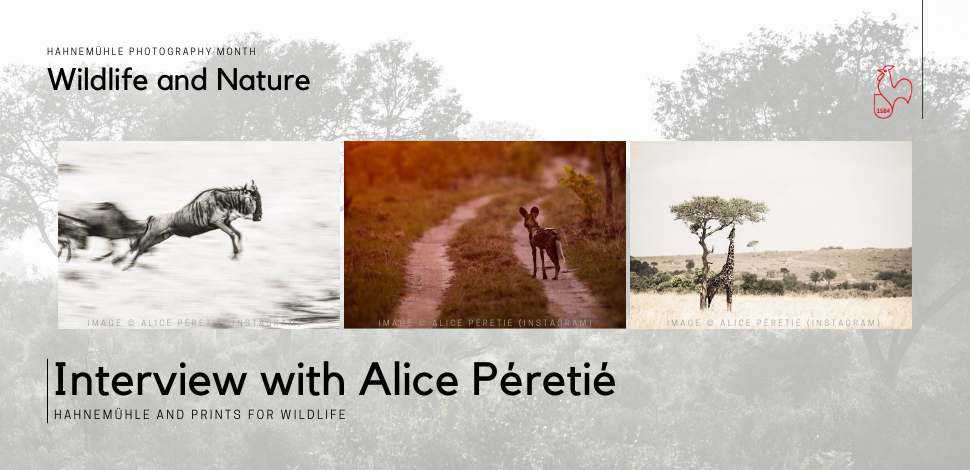We are back with another Hahnemühle Photography Month. This year we want to show how diverse photography and fine art printing is and can be. Each week we will focus on selected highlights and topics. During our first week, we will talk about Wildlife and Landscape Photography and how it can follow a mission. Together with our friends from Prints for Wildlife, we will share various videos, images and interviews from participating photographers.
Alice Perétié is the second photographer in our interview series during the first week of the Hahnemühle Photography Month.
Could you introduce yourself in 3-4 sentences?
“My name is Alice, I’m a French wildlife and conservation photographer and writer from London, which means that I work as a creative consultant for conservation organisations or related business, as well as creating prints to directly support conservation. I’ve just turned 24, and used to teach Philosophy and Literature when I was at uni to pay for my equipment and trips…it was a side thing until I realised how much I loved teaching, and how relevant these disciplines are to talk about conservation and nature – everything is linked! I continued teaching after graduating, not just teenagers, but also adults who wish to work on exploring new concepts and perspectives. I incorporate this a lot in my writing, in my way of communicating conservation, and even in my photographic and creative process, as I strongly believe that understanding human nature is key to achieving results on the conservation front.”
How and When did you figure out you wanted to become a Wildlife/Nature photographer?
“I’ve always loved photography, I remember being ecstatic when taking photos with the little disposable kodaks – I must have been 7 or 8 maybe. The excitement when taking the film to be developed is still quite vivid in my mind! Eventually I found myself with a little digital camera that my parents had forgotten about, that followed me for years until I started shooting with an entry level DSLR. Although I’ve lived in London my whole life, I’m originally from Burgundy, in Central France. We’d spend hours driving or walking around looking for wildlife with my mum and brother….from as young as I can remember, I’ve always had a fascination for the natural world. This has really translated into my photography, as I’m much more interested in photographing landscapes, natural textures and wildlife than people (though this is changing a bit). Weirdly, I’m fascinated about writing about people, projects and the stories of interconnections, about the links between people and the environment. Photographs and stories go hand in hand, for some things need to be seen and others heard.
But more importantly, I started understanding that there was a huge gap in the understanding of what wildlife conservation is today, and people imagine it is. Today, it’s about protecting healthy ecosystems and supporting both people and nature. It’s talking about ecological and socio-economic well-being and seeing how closely they are linked. And I think conservation suffers from its reputation of being elitist, or of not being as important as other aspects of society that also need attention – why save animals when people are hungry, when there’s mass poverty? But there shouldn’t be a choice, and today, protecting nature means protecting people. Societies cannot be healthy if their ecosystem is not. I’m incredibly passionate and determined to challenge people into reflecting about how relevant nature protection is to them – it’s not just for hippies or certain social classes. Life is life, it knows no human boundaries. So I decided to work on deconstructing that and bringing these socio-ecological gaps to light. Bridging the divide between nature and culture…
This impulse naturally grew, initially as a hobby when I was studying (I studied a conservation related degree, oriented towards development and governance as well as ecology), and then it naturally developed into my job! It was after working in Kenya and then traveling to the Democratic Republic of the Congo (Virunga National Park), I’d just turned 20, that I started using my work as a way to fundraise for conservation, specifically at the time for Lewa Wildlife and Virunga National Park – half of my proceeds are donated to projects I’ve worked with or that I trust, and I use exhibitions and conferences to explore how these projects can be models for our own ways of life, why conservation starts at home and with our own habits. Since then, it’s grown into a beautiful project that I’m very excited about. There’s something incredibly powerful about creation, and about being able to see physical marks of the creative process. I love it!
There’s multiple things when I photograph, I think in terms of goal. It’s about giving back, it’s about telling a story and it’s about somehow enthralling the viewer into being curious about nature, into wanting to know more or to get involved. The philosophical issue of the bridge and divide between nature and culture is extremely old, and one that absolutely fascinates me. I think photography, or any form of art, can be a powerful medium towards reconnecting people and nature, and therefore cannot dissociate photography from conservation simply because conservation for me is about our connection with the natural world. I long for the day where we don’t need to justify preserving forests or protecting rhinos.
In terms of creative mission, there’s something about nature, about light, about elements that make me feel alive, and I suddenly feel an urge to create with this. It’s a weird feeling – there’s some scenes that I’m very happy to sit in and not even think about my camera, including being surrounded by elephants on foot, or looking at a leopard sleeping in a tree. The moment is powerful and must be respected – I don’t think everything needs to be photographed. But then again, different elements speak to us individually and in different ways. And then there’s others, like the Mopane Forest in the South Luangwa (Zambia), that I just had to photograph. There was no animal, nothing some people might see as exciting but the thick dark trees, the emerald canopy, the 4pm light filtering through the trees – I couldn’t help myself. In fact, I distinctly remember holding up the vehicle (full of photographers) who wanted to go check out some lions that had been radioed in, just because I wanted to get everything right. Patience is a virtue in photography ;)”
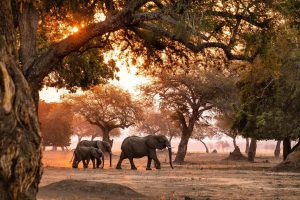
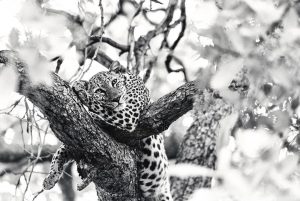
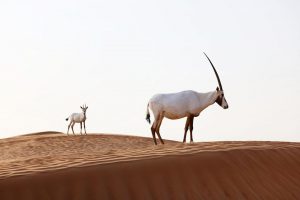
Why do you print your images?
“Printing is paramount for me as it brings a story to life. Prints are a daily reminder of the natural world around us when hung on a wall, and that reminder affects the subconscious every day, little by little. But without printing I would find it harder to support conservation in the way I do. I love the idea of building a relationship with people from around the world through art, and around nature. It’s all linked – art is something that makes us feel – and makes us – human, especially when it comes to appreciating Beauty and the consciousness of it. Beauty is a wonderfully positive concept to work with, to be inspired by, I believe it can bring people together – we all have the capacity, as humans, to appreciate it, regardless of where we come from. It speaks to us in so many different ways. All these notions, life, love, Beauty, creativity, nature, humanity, art – they are so deeply interconnected, venerated and explored since the beginnings of culture, and I find that both fascinating and inspiring for my work as a photographer and writer.
But as humans, we are a part of broader ecosystems, which we tend to forget. It’s therefore important to me to find and create reminders of both our human and natural conditions, and wildlife/ nature photography is, I believe, ideal for this.
This may come across as a little despondent- which is most certainly not my intention,- but for me, photographs are meant to be printed. It broke my heart (well not really, but I was incredibly frustrated), coming back from a trip one day, thinking that my photos would just be on the back end of a hard drive or end up compressed on social media amongst millions of other photos. That was the stepping point for me to build my website, and then a year later use my work in a way that could give back to conservation.
Printing in itself is a new way to interpret the photograph. I’m intimately convinced of this, and actually realised by accident when I was inattentive and printed a photo for a client on the wrong paper. That mistake opened up an entire new world of possibilities and I suddenly became very passionate about using different papers for different photographs and found myself with two different stories and visuals.”
When it comes to the paper choice – why did you go for Hahnemühle?
“The love story with Hahnemühle began a few years ago – and by complete accident. I use The Printspace in London to print my work, and they offer a range of inkjet impressions. I sent off a print order (for a gift) a little too quickly, and the print came to me in German Etching rather than the other medium I had in mind. Initially worried when I saw the invoice, upon unravelling the print I was absolutely ecstatic. The textures of the tree, the leopard’s paw, the colours – there was so much depth, and I was pulled into the print purely through the magic worked by the paper. This one quickly became a favourite for printing anything heavily textured, like forests, animal details (like leopard tails, or their beautiful coats) or dramatic landscapes like the Nyiragongo Volcano crater. It’s also great to mount the print, as the paper is durable and works like a canvas.
After that happy moment, I explored other papers from Hahnemühle that the printing lab offered, and another one of my go-to papers was the Hahnemühle Pearl. My goodness, the quality and the oil painting feel of the final product made me bounce with joy when I unwrapped the print every time. I use Pearl for prints that have strong contrasts in the light, that need a bit of shine – but not too much. It’s just so beautiful, and my clients love it.
I’ve also started exploring the Bamboo paper, as that’s the last Hahnemühle option available at my lab. I love the softness of it, and the meaning behind it. I’d like to use it in the same way I do the German Etching, and am for now using it as a test with cards and smaller prints, before getting into the bigger ones. It’s such a powerful statement, I think, to be able to print sustainably and follow ethics from start to finish in the entire creative process. we have a responsibility to do better, always. I’m excited that Prints for Wildlife are using Hemp, as I’m curious to see the result, and hope that the Printspace will also start opening up to more papers from Hahnemühle – they are incredibly active on the sustainability front so I’m sure this is a possibility.”
What is one of the funniest/ most spectacular/ formative/ emotional or unforgettable memory you have made while shooting and/or printing?
“In terms of photography, two moments come to mind.
The first, is actually an entire trip I took almost three years ago (how has it been so long? I’m still stuck in 2019…) to Mana Pools (Zimbabwe) – which instantly became my favourite place in the world. It is spectacular in Beauty, and I never experienced anything like it. Every time I closed my eyes for the months following my trip there, I would see the mystical light pool around me, sparks of gold engraved behind my eyelids. My soul definitely didn’t come back whole from Mana, (and it’s time for me to go back and look for it haha).
Photographically, I found it challenging in the most wonderful way because it’s about looking for the less obvious – different species, different plays with the chiaroscuro, waiting endlessly for interactions between light and dust, light and water, light and forest. It was different from anything I’d done before. There, we roam on foot, and the vast majority of sightings are baboons, eland, impala and elephants. Sometimes buffalo and wild dogs, lots of birds. But you definitely don’t have leopards falling out of trees, or endless lion prides. It’s a harsh environment, and a place where the dynamics between environment and the animal should be considered from a photographic perspective. Suddenly, baboons and hyenas become beautiful creatures bathing in pools of dazzling golden and pink light filtering through the Albida forest. It’s stunning.
I’ve never been a huge fan of photographing animal portraits because I love looking at the relationship between animal and landscape, the ecosystem dynamics. Especially in a place like Mana! As beautiful as animal portraits can be… I often find that it removes the particularity of the landscape and can soon become something that isn’t as powerful a story. But that’s very personal! That trip to Mana opened my eyes, forced me to look ‘through’ and not ‘at’, to interpret rather than simply click a photo. I started to fully understand what creating a photo meant, as opposed to taking one, just because the creative possibilities are endless in a place like that. Maybe it was also the fact that on foot, everything is different sensually – awareness is heightened, especially when it’s 47 degrees celsius – and I wanted to translate these feelings. I was no longer a stranger to the ecosystem (well I was, but it didn’t feel like it as much as it often does when safely behind a vehicle). From that moment, my work started changing, and so did my approach to it.
There’s another particular moment that comes to mind – I love leopards and have a fascination for them. I don’t know if I have a favourite animal to photograph, but leopards and elephants are two creatures I adore spending time with. I’m very much a cat person and my cats at home behave like miniature versions of leopards haha. I was in the South Luangwa a few years ago, a place very famous for its leopard density. Leopards quite literally fall out of trees there (though that’s a story for another time). The sightings throughout the week had been incredible. I love travelling to the Zimbabwe-Zambia-Malawi regions in October because it’s the height of the dry season, and the light filters through dust in a wondrous way – almost rivalling Mana Pools. Colours are warm pastel in the mornings and evenings, the harshness has a magic to it.
One my last night, we were driving back to camp, and a leopard appeared out of nowhere in the dark – a big male. Patrick, our guide, anticipated where he would go, and we drove in the opposite direction to position ourselves by a stream at the bottom of a gully. Less than 2 minutes later, we heard gentle padding down the slope, until the male arrived into the gentle beam of light created by the spot. The entire scene was one of gold and inky night, and as he leaned forward to drink, the ripples caught the light and reflected his beautiful face. His eyes were the same colour as his pelt, and he stared at us whilst lapping the water. He was incredibly relaxed, and it was a moment of pure Beauty. We all felt it in the car.
I wanted to capture just the leopard and his reflection, for the gold and black to dance with no distractions around that could otherwise be caught in the spot, and underexposed a lot to just catch the glimmer and the suggestion. But that was only half of it – I’d had a particular shot in mind for ages, that of a backlit leopard, and by some incredible stroke of luck, after he left the pond, the cat advanced between the other vehicle returning to camp and ours. Their spot illuminated the leopard from the back, and a golden silhouette shone in our direction. Again, it was a moment of pure Beauty.”
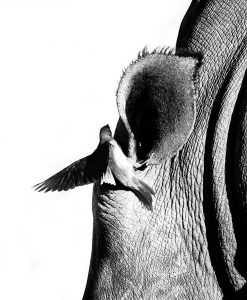
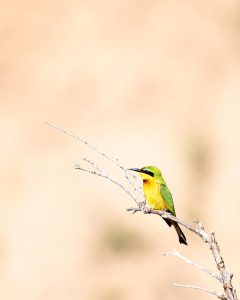
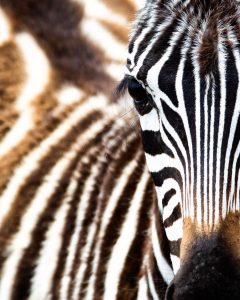
Why do you support Prints for Wildlife with your work and why do you think the cause is important?
“Photography has always been a way for me to give back to the natural world, to support as best I can (for now) and it’s incredibly exciting to be a part of the wonderful initiative that is Prints for Wildlife, as the values are so very much aligned with what I’ve always strived to apply with my work. I love seeing how many photographers not only find Beauty, honour it, but also are engaged in protecting it – Beauty, life, nature, love, ecosystems, society – it’s all connected and intertwined. We’re all in this together.
Conservation is too important – it’s more than just ‘saving animals’, it’s an interconnected way of re-designing our relationship with the natural world, involving all spheres of society. The disconnect is huge, between man and the environment, and it’s high time we rethink our relationship with our ecosystems. Yes, for now limiting the damage, preserving the last biodiverse spaces in the world is paramount, and African Parks is a wonderful organisation that does this. As mentioned above, photography and art are a great way to bridge the gap between people and nature, and it’s an honour to contribute to such a huge fundraiser. Prints For Wildlife sends off a powerful message in terms of collaboration, togetherness and showing that we’re all very united in wanting to not just raise awareness to the plight of ecosystems but to do something about it. Associating with African Parks, an organisation with an incredible track record that has brought life back to areas that were all but abandoned, is powerful.
Hopefully, this spreads a message to people world wide about the importance of conservation – every time they look at their print, in fact.”
Learn more about Alice’s work on her website, Instagram and Blog.
Prints for Wildlife is a fundraiser aiming to ensure protected areas continue to deliver benefits to people and wildlife during the COVID pandemic. More than 170 wildlife photographers, including renown international and emerging and local wildlife photogrpahers, have come together to mobilise needed support for one cause: to continue the protection of vital landscapes in Africa. The fundraiser runs from 11 July to 11 August 2021. All funds collected via the print sale go directly to conservation non-profit African Parks. The price per print is 100 USA excluding shipping. 100% of the proceeds (after printing and handling) will be donated to African Parks. All prints are printed on our sustainable Natural Line Paper Hahnemühle Hemp from our Digital FineArt Collection.
Make sure check out the images Alice donated to the Prints for Wildlife fundraiser.
For more information about this year’s Hahnemühle Photography Month follow our Instagram @hahnemuehle_imaging and Facebook @hahnemuehle.


